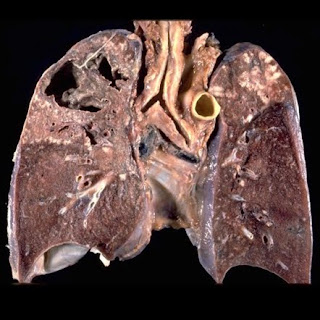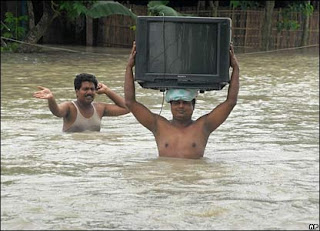Saturday, July 23, 2011
Tuesday, July 19, 2011
Floods in Bangladesh
The South Asian country of Bangladesh is prone to the natural disaster of flooding due to being situated on the Ganges Delta
is prone to the natural disaster of flooding due to being situated on the Ganges Delta and the many tributaries
and the many tributaries flowing into the Bay of Bengal
flowing into the Bay of Bengal . The coastal flooding twinned with the bursting of Bangladesh's river banks is common and severely affects the landscape and Bangladeshi society. 75% of Bangladesh is less than 10m above sea level and 80% is flood plain, therefore rendering Bangladesh a nation very much at risk of further widespread damage despite its development, especially as its present flood defenses are unsustainable and somewhat amateur. Flooding normally occurs during the monsoon season from June to September during the monsoon. The convectional rainfall of the monsoon is added to by relief rainfall caused by the Himalayas
. The coastal flooding twinned with the bursting of Bangladesh's river banks is common and severely affects the landscape and Bangladeshi society. 75% of Bangladesh is less than 10m above sea level and 80% is flood plain, therefore rendering Bangladesh a nation very much at risk of further widespread damage despite its development, especially as its present flood defenses are unsustainable and somewhat amateur. Flooding normally occurs during the monsoon season from June to September during the monsoon. The convectional rainfall of the monsoon is added to by relief rainfall caused by the Himalayas . Meltwater from the Himalayas is also a significant input and flood every year.
. Meltwater from the Himalayas is also a significant input and flood every year.
Each year in Bangladesh about 26,000 km2, (around 18%) of the country is flooded, killing over 5,000 people and destroying 7 million homes. During severe floods the affected area may exceed 75% of the country, as was seen in 1998. This volume is 95% of the total annual inflow. By comparison, only about 187,000 million m3, of streamflow is generated by rainfall inside the country during the same period. The floods have caused devastation in Bangladesh throughout history, especially during the years 1966, 1987, 1998 and 1988. The 2007 South Asian floods also affected a large portion of Bangladesh.
Small scale flooding in Bangladesh is required to sustain the agricultural industry, as sediment deposited by floodwater fertilizes fields. The water is required to grow rice, so natural flooding replaces the requirement of artificial irrigation, which is time consuming and costly to build. Salt deposited on fields from high rates of evaporation is removed during floods, preventing the land from becoming infertile. The benefits of flooding are clear in El Niño  years when the monsoon is interrupted. As El Nino becomes increasingly frequent, and flood events appear to become more extreme, the previously relaiable monsoon may be succeeded by years of drought or devastating floods. Also, some 3 thousand people were left homeless or killed.
years when the monsoon is interrupted. As El Nino becomes increasingly frequent, and flood events appear to become more extreme, the previously relaiable monsoon may be succeeded by years of drought or devastating floods. Also, some 3 thousand people were left homeless or killed.
Categories
In Bangladesh, the following types of floods are normally encountered.
Flash floods in the eastern and northern rivers are characterized by a sharp rise followed by a relatively rapid recession, often causing high flow velocities that damage crops and property.
Local floods due to high localized rainfall of long duration in the monsoon season often generate water volumes in excess of the local drainage capacity, causing localized floods due to drainage congestion.
due to high localized rainfall of long duration in the monsoon season often generate water volumes in excess of the local drainage capacity, causing localized floods due to drainage congestion.
Monsoon floods from the major rivers generally rise slowly and the period of rise and fall may extend from 10 to 20 days or more. Spilling through dis tributaries and over the banks of the major rivers causes the most extensive flood damage, particularly when the three major rivers rise simultaneously.
Floods due to storm surges in the coastal areas of Bangladesh, which are generated by tropical cyclone, cause extensive damage to life and property. These cyclones are predominant during the post-monsoon (October and November) and pre-monsoon (April to June) period.
in the coastal areas of Bangladesh, which are generated by tropical cyclone, cause extensive damage to life and property. These cyclones are predominant during the post-monsoon (October and November) and pre-monsoon (April to June) period.
Flood history Bangladesh
§ Bangladesh has been victim of numerous floods throughout the years, the major ones being in 1954, 1955, 1970, 1985, 1988, 1998, 2007
Floods In Bangladesh
1. Flooding in Bangladesh Where does the flooding occur? Identify specific regions that are worst hit.
2. Causes of Flooding in Bangladesh
o Human causes of flooding in Bangladesh
o Intense deforestation in the Himalayas has led to less trees and more soil erosion. This leads to less interception and more water and silt in the river.
o Bangladesh is an LEDC and its lack of money and heavy national debt means that little money is available to spend on flood protection methods / defences and many existing defences lack upkeep and are of questionable use
o Physical (Natural) causes of flooding in Bangladesh
o Bangladesh is a very low lying country, with 70% of its land area being less than 1m above sea level and 80% of it being floodplain.
o Bangladesh receives large amounts of water passing through it with two major rivers (the Ganges and Brahmaputra) converging and forming a huge delta.
o Bangladesh has a monsoon climate and the annual torrential rains which result often result in the rivers exceeding their capacity and flooding;
o In the spring, melting snow from the Himalayas further increases the flood risks as torrents of melt water enter the rivers at their source.
3. Effects of the 1998 Bangladesh Floods
o Over two thirds of the land area was covered by water and the capital, Dhaka, was 2m underwater.
o 30 million people were made homeless in the floods with many losing all their belongings.
o 1,070 people died - this death toll resulted from a number of things. As well as people being killed by drowning in the flood waters, health problems increased the number of deaths further. Contamination of water by waste and dead bodies / animals, and the lack of a clean water supply resulted in the spread of disease such as cholera and typhoid. Further deaths from snake bites and other injuries which led to death through the lack of access to medical care.
o Food supplies were severely affected as flooding destroyed the rice stocks with a total of 668,529ha of crops being destroyed;
o The impact on the economy was significant with Bangladesh's export industries seeing a 20% decrease in production with over 400 clothing factories forced to close.
o Communications became difficult, with shopping impossible in the main port, as well as roads and railways having been swept away making the distribution of aid and the rescue operation very difficult;
o As well as providing water for crops, when flooding occurs, as there is friction between the water and the surface of the land, the water slows down and loses its energy. This loss of energy results in the deposition of rich fertile soil resulting in the providing important nutrients enabling people to grow crops;
o This deposition of silt also creates land upon which people can live - for example the Ganges delta has been formed in this way as deposition has occured where the river has entered the Bay of Bengal.
POSITIVE EFFECTS OF FLOODING
4. Responses to the 1998 Floods
o SHORT TERM
o 1. International food aid programmes set up.
o 2. The distribution of free seed to farmers by the Bangladesh government to try and reduce the impact of food shortages - the government also gave 350,000 tonnes of cereal to feed people;
o Volunteers / aid workers worked to try and repair flood damage
o LONG TERM
o The creation of embankments (artificial levees) along the river to increase channel capacity & restrict flood waters
o Constructing flood protection shelters (large buildings raised above the ground) to shelter both people and animals
o Emergency flood warning systems and plans made for organising rescue and relief services;
o Providing emergency medical stores in villages
o Building flood proof storage sheds for grain and other food supplies
o Dam construction upstream and major embankments around Dhaka have been suggested however lack of money has meant that these suggestions have not been taken further.
5. See how much you have remembered – Have a go at the activities on the next few slides!
6. Sort the statements above into 2 categories: Causes and Effects Ext: Break each category into sub-categories. Electricity supplies disrupted. 1040 people dead in the floods. ¼ million affected by diarrhea. Shipping from main port was disrupted. Over 400 factories closed. Heavy monsoon rains between May and October cause river levels to rise. 6500 bridges damaged Bangladesh is heavily in debt – has no money to spend on flood prevention projects. Many of the existing flood defenses do not work. Relied/aid efforts affected due to damage to raod and rail links. 80% of the country was covered by at least 1 metre of floodwater. 11 000km of roads damaged. Building of new towns in Nepal and China has destroyed large areas of forest. Rocks, sand and mud from the Himalayas is washed into the river channel. 500 000 cattle killed. 2.5 million farmers affected. 6500 bridges destroyed 23.5 million people made homeless. Melting snow from Himalayas added water into rivers flowing through Bangladesh Some areas underwater for over 2 months. Airport flooded – aid couldn’t get in from abroad. Health: Water supplies contaminated for ¼ million people. 80% of Bangladesh is less than 10m above sea level
7. Flooding in Bangladesh Why does Bangladesh flood? Split answers into Physical and Human causes. Bangladesh also suffers regularly from substantial flooding caused by monsoon rains and melting snows from the Himalayas. Source: World Infozone.com Freshwater floods occur when a watershed receives so much water that it cannot drain into the soil quickly enough to take the water away. Bangladesh has three mighty rivers, the Ganges, the Jamuna and the Meghna. Most floods follow heavy rain or melting snow, frozen ground and already high river levels. The floods in Bangladesh begin through a combination of heavy monsoon rains flooding the rivers and abnormally high tides in the Bay of Bengal preventing floodwater from running off the land and into the sea. The likelihood of flooding can be increased by human activities too, such as too many trees being cut down, stripping the land bare of the vital top soil which slows and drains water. Also, In built-up areas with a lot of concrete roads and houses, there are fewer places for water to go and less soil for water to drain into. So planners in cities prone to flooding have to develop ways of channelling water to cope with potential floods. Source: Global Express.org Bangladesh is a delta. The low level of the delta land means that the country is prone to flooding. 75% of Bangladesh is at or below just 10 metres in height. Source: BBC
Subscribe to:
Comments (Atom)








































